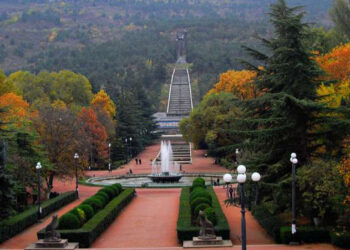Seventeen years have passed since the start of the brief but devastating August 2008 war between Georgia and Russia on August 7. The five-day conflict, sparked by escalating tensions in the breakaway region of South Ossetia, left deep scars on the country — both physically and politically.
According to official data, 170 servicemen from the Ministry of Defense, 14 employees of the Ministry of Internal Affairs, and 224 civilians were killed during the war. The Ministry of Labor, Health, and Social Affairs reported that a total of 2,232 people — both civilians and military personnel — were wounded or injured.
The Ministry of Defense notes that among the 1,045 wounded servicemen, the heaviest losses were suffered by the IV Mechanized Brigade with 271 wounded, and the II Infantry Brigade, which saw 251 of its troops injured in action.
“This war changed the security architecture of the region. Its consequences are still felt by our soldiers, our families, and all Georgian citizens,” said former defense minister Davit Kezerashvili in a 2013 interview reflecting on the war’s long-term impact.
20% of Georgia Under Occupation
Today, approximately 20% of Georgia’s internationally recognized territory remains occupied by the Russian Federation, which continues to station troops and build infrastructure in the regions of Abkhazia and the Tskhinvali region (commonly referred to by Russia as ‘South Ossetia’).
Russia has fortified the so-called “administrative boundary lines” with barbed wire fences, observation towers, and trenches, cutting through Georgian villages and farmland. Residents of areas near the occupation line live in constant fear, subject to illegal detentions, kidnappings, and arbitrary arrests.
“Every day, our citizens are detained while tending their gardens or crossing invisible lines drawn by the occupiers,” said Georgia’s Public Defender in a 2022 annual report. “These actions violate fundamental human rights and create a climate of fear.”
In defiance of international law, Russia recognized the independence of Abkhazia and South Ossetia just days after the war. This move was widely condemned.
“Russia’s recognition of Abkhazia and South Ossetia was a blatant violation of Georgia’s sovereignty and territorial integrity,” said then-UN Secretary-General Ban Ki-moon in 2008.
To this day, the vast majority of the international community, including the European Union, NATO, and the United Nations, do not recognize the independence of these regions. Georgia’s partners continue to call for the full withdrawal of Russian forces and the return of internally displaced persons (IDPs) to their homes.
Human Toll and Legacy
The war created a new wave of internal displacement, adding to the hundreds of thousands already displaced during the conflicts in the 1990s. Many displaced families remain unable to return to their homes in Abkhazia and South Ossetia.
“We left everything behind in one night — our house, our fields, even the family photos,” recalls Nino, an IDP from Akhalgori, now living in a settlement near Tserovani. “Seventeen years later, we are still waiting to go home.”
Despite the trauma and ongoing occupation, Georgia continues to move toward integration with Western institutions. The country signed an Association Agreement with the European Union in 2014 and has consistently received support from NATO allies.
“We reaffirm our unwavering support for Georgia’s sovereignty and territorial integrity within its internationally recognized borders,” stated a 2024 resolution by the European Parliament. “Russia must end its occupation and fulfill its obligations under the 2008 ceasefire agreement.”
As Georgia marks the 17th anniversary of the war, remembrance ceremonies and discussions across the country emphasize both the cost of conflict and the enduring struggle for peace, justice, and national unity.














